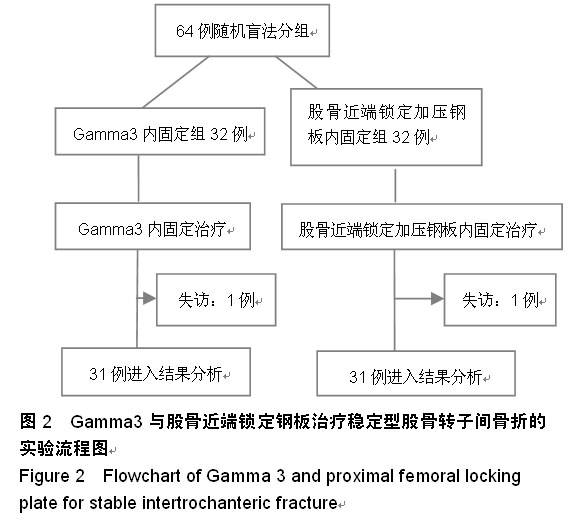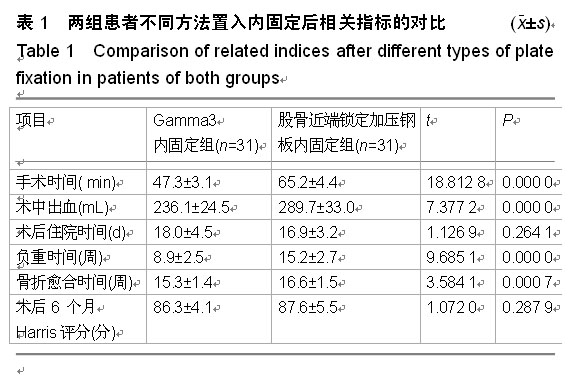| [1] 王亦璁,姜保国.骨与关节损伤[M].5版.北京:人民卫生出版社,2012: 1160-1163.
[2] Bozic KJ, Kurtz SM, Lau E, et al. The epidemiology of revision total hip arthroplasty in the United States. J Bone Joint Surg Am. 2009;91(1):128-133.
[3] 谢晶晶,宋烜,王占朝,等.内外侧锁定钢板固定胫骨远端骨折的比较[J].中国组织工程研究,2013,17(43):7636-7641.
[4] van Embden D, Rhemrev SJ, Meylaerts SA, et al. The comparison of two classifications for trochanteric femur fractures: the AO/ASIF classification and the Jensen classification. Injury. 2010;41(4):377-381.
[5] Tei K, Kubo S, Matsumoto T, et al. Combined osteochondral fracture of the posterolateral tibial plateau and Segond fracture with anterior cruciate ligament injury in a skeletally immature patient. Knee Surg Sports Traumatol Arthrosc. 2012; 20(2):252-255.
[6] Peleg E, Mosheiff R, Liebergall M, et al. A short plate compression screw with diagonal bolts--a biomechanical evaluation performed experimentally and by numerical computation. Clin Biomech (Bristol, Avon). 2006;21(9):963-968.
[7] 谭三智,黄桂填. DHS和PFN治疗股骨粗隆间骨折的疗效分析[J].实用医学杂志,2010,26(18):3395-3396.
[8] Canale TS,Beaty JH.坎贝尔骨科手术学[M].王岩,译.11版.北京:人民军医出版社,2009:2538-2539.
[9] 鲁英,罗先正.203例股骨粗隆间骨折治疗分析[J].骨与关节损伤杂志,1991,6(1):7-9.
[10] Bojan AJ, Beimel C, Speitling A, et al. 3066 consecutive Gamma Nails. 12 years experience at a single centre. BMC Musculoskelet Disord. 2010;11:133.
[11] Peltola EK, Mustonen AO, Lindahl J, et al. Segond fracture combined with tibial plateau fracture. AJR Am J Roentgenol. 2011;197(6):W1101-1104.
[12] Liu M, Yang Z, Pei F, et al. A meta-analysis of the Gamma nail and dynamic hip screw in treating peritrochanteric fractures. Int Orthop. 2010;34(3):323-328.
[13] Veitch SW, Stroud RM, Toms AD. Compaction bone grafting in tibial plateau fracture fixation. J Trauma. 2010;68(4):980-983.
[14] 徐耀增,耿德春,王现彬,等.防旋股骨近端髓内钉与第三代Gamma钉治疗老年股骨转子间骨折的对比研究[J].中华创伤杂志,2011, 27(1):33-37.
[15] Pernaa K, Koski I, Mattila K, et al. Bioactive glass S53P4 and autograft bone in treatment of depressed tibial plateau fractures - a prospective randomized 11-year follow-up. J Long Term Eff Med Implants. 2011;21(2):139-148.
[16] 胡力.股骨转子间骨折的内固定器应用进展[J].中国矫形外科杂志, 2013,21(10):989-992.
[17] 国家体育总局. 2010年国民体质监测公报.2011-9-2.
[18] Arjona-Giménez C, Navarrete-Jiménez JD, Nieto-Rodríguez O. Lobenhoffer approach to stabilize fractures of the posteromedial tibial plateau. Acta Ortop Mex. 2013;27(6):380-384.
[19] Zha GC, Chen ZL, Qi XB, et al. Treatment of pertrochanteric fractures with a proximal femur locking compression plate. Injury. 2011;42(11):1294-1299.
[20] Vasanad GH, Antin SM, Akkimaradi RC, et al. "Surgical management of tibial plateau fractures - a clinical study". J Clin Diagn Res. 2013;7(12):3128-3130.
[21] Seral B, García JM, Cegoñino J, et al. Finite element study of intramedullary osteosynthesis in the treatment of trochanteric fractures of the hip: Gamma and PFN. Injury. 2004;35(2): 130-135.
[22] Sitthiseripratip K, Van Oosterwyck H, Vander Sloten J, et al. Finite element study of trochanteric gamma nail for trochanteric fracture. Med Eng Phys. 2003;25(2):99-106.
[23] Ferreira N, Marais LC. Bicondylar tibial plateau fractures treated with fine-wire circular external fixation. Strategies Trauma Limb Reconstr. 2014;9(1):25-32.
[24] Albuquerque RP, Hara R, Prado J, et al. Epidemiological study on tibial plateau fractures at a level I trauma center. Acta Ortop Bras. 2013;21(2):109-115.
[25] Rydell N. Biomechanics of the hip-joint. Clin Orthop Relat Res. 1973;(92):6-15.
[26] 李必奎,陈周兵,徐富生.股骨近端锁定钢板治疗股骨转子间骨折[J].中国修复重建外科杂志,2011,25(10):1273-1275.
[27] Dall'oca C, Maluta T, Lavini F, et al. Tibial plateau fractures: compared outcomes between ARIF and ORIF. Strategies Trauma Limb Reconstr. 2012;7(3):163-175.
[28] Norris R, Bhattacharjee D, Parker MJ. Occurrence of secondary fracture around intramedullary nails used for trochanteric hip fractures: a systematic review of 13,568 patients. Injury. 2012; 43(6):706-711.
[29] Flautt W, Miller J, Ratcliff JR. Lateral tibial plateau fracture. J Orthop Sports Phys Ther. 2012;42(9):819.
[30] Werner CM, Scheyerer MJ, Schmitt J, et al. Minimally invasive balloon-assisted reduction and internal fixation of tibial plateau fractures. Unfallchirurg. 2012;115(12): 1126-1132.
[31] 张波,潘显明,权毅,等.三种内固定器治疗股骨颈骨折的临床观察及生物力学分析[J].西南国防医药,2002,12(3):210-212.
[32] 孙强,许平安,郑加法.三种手术方式固定不稳定性股骨转子间骨折的生物力学研究[J].中华创伤杂志,2012,28(12):1078-1082.
[33] Windolf J, Hollander DA, Hakimi M, et al. Pitfalls and complications in the use of the proximal femoral nail. Langenbecks Arch Surg. 2005;390(1):59-65.
[34] 刘瑞波,白音,孔令英,等.力臂式外固定器治疗股骨粗隆间骨折实验研究和临床应用[J].中国骨伤,1999,12(2):20-23.
[35] Okcu G, Ozkayin N, Okta C, et al. Which implant is better for treating reverse obliquity fractures of the proximal femur: a standard or long nail? Clin Orthop Relat Res. 2013;471(9): 2768-2775.
[36] 张俊,王劲,何爱咏.股骨近端锁定钢板置入内固定修复老年股骨转子间陈旧性骨折[J].中国组织工程研究,2014,18(22): 3475-3480.
[37] Gadegone W, Lokhande V, Salphale Y, et al. Long proximal femoral nail in ipsilateral fractures proximal femur and shaft of femur. Indian J Orthop. 2013;47(3):272-277.
[38] 孟位明,李彦眉,许红生,等.股骨转子下骨折植入物髓外及髓内固定治疗的规范化[J].中国组织工程研究,2014,18(22): 3587- 3592.
[39] Kumar R, Singh RN, Singh BN, et al . Comparative prospective study of proximal femoral nail and dynamic hip screw in treatment of intertrochanteric fracture femur. J Clin Orthop Trauma. 2012;390(1):28-36.
[40] 胡阿威,喻爱喜,夏成焱,等.四种内固定方法治疗老年股骨转子间骨折的对比研究[J].中华全科医师杂志,2013,12(3):185-188.
[41] Andruszkow H, Frink M, Frömke C, et al. Tip apex distance, hip screw placement, and neck shaft angle as potential risk factors for cut-out failure of hip screws after surgical treatment of intertrochanteric fractures. Int Orthop. 2012;36(11): 2347- 2354.
[42] 贾燕飞,冯卫,佟雁翔.三种内固定方法治疗老年股骨转子间骨折的比较[J].中华创伤骨科杂志,2011,13(2):130-134.
[43] Kouvidis G, Sakellariou VI, Mavrogenis AF, et al. Dual lag screw cephalomedullary nail versus the classic sliding hip screw for the stabilization of intertrochanteric fractures. A prospective randomized study. Strategies Trauma Limb Reconstr. 2012;7(3):155-162.
[44] 汤欣,刘谟震,于利,等.新一代髓内钉InterTAN在股骨转子间骨折治疗中的应用[J].中华创伤骨科杂志,2010,12(9):814-818.
[45] Knobe M, Gradl G, Ladenburger A, et al. Unstable intertrochanteric femur fractures: is there a consensus on definition and treatment in Germany? Clin Orthop Relat Res. 2013;471(9):2831-2840.
[46] Matre K, Havelin LI, Gjertsen JE, et al. Intramedullary nails result in more reoperations than sliding hip screws in two-part intertrochanteric fractures. Clin Orthop Relat Res. 2013;471 (4): 1379-1386.
[47] 郝伟,王新,周路纲,等.老年股骨转子间骨折不同治疗方法对比研究[J].中华创伤杂志,2014,31(6):1362-1364.
[48] 徐厚高.股骨近端防旋髓内钉与动力髋螺钉修复老年股骨转子间骨折的比较[J].中国组织工程研究,2014,18(35):5611-5615.
中国组织工程研究杂志出版内容重点:人工关节;骨植入物;脊柱;骨折;内固定;数字化骨科;组织工程
|



.jpg)